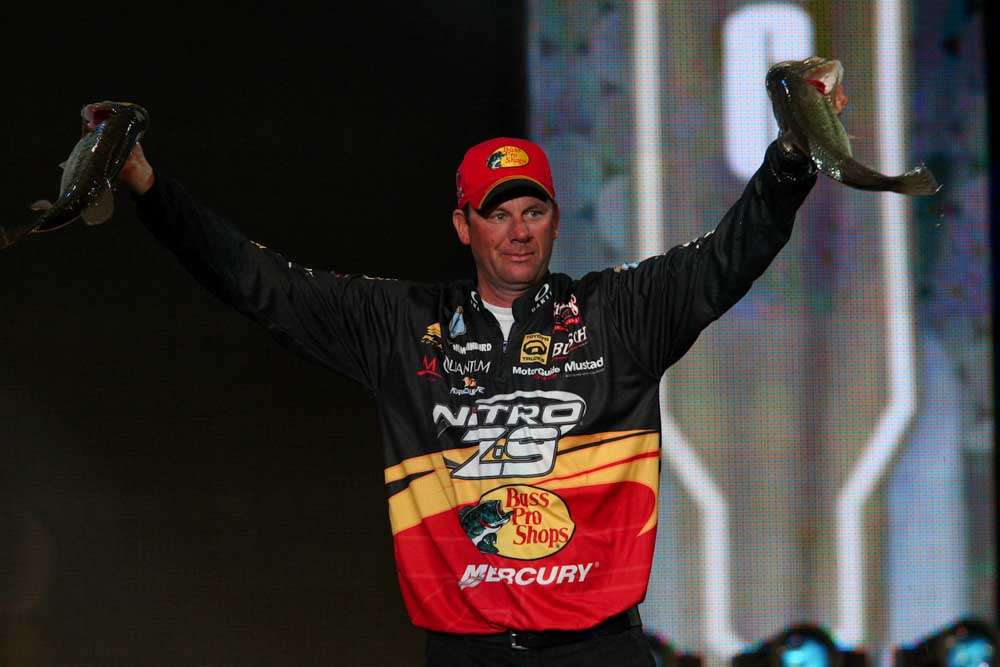
Most anglers think you have to fish ultra slow or use finesse tactics during cold winter months.
While it’s true that a bass’ metabolism slows down, he still has to eat. And remember, the baitfish continue to dart and glide quickly for survival, so a bass has to move equally fast to eat during cold water months.
Therefore, I still stick to my power fishing principles because I can cover a lot of water, but I work them differently to match the conditions.
Here are the five baits I will have rigged for cold weather fishing and how I use them:
Jerkbait
This is my favorite choice for lakes that have clear water.
Bass are focused on shad during the winter, and I prefer a suspending jerkbait for fishing around vertical structure, like main lake bluffs and bridges, this time of year. When the water is colder, the shad suspend in the water column and if I see shad dying and gulls diving on them, that tells me the suspending jerkbait is the best choice. I will snap it a few times and let it sit a little longer than I do in the summertime, but always experiment with the action until I know how they want it.
Red Eye Shad
The lipless crankbait can be dynamite on cold, lowland reservoirs or natural lakes, especially if there is vegetation. It’s very efficient for covering a lot of water.
However, I do slow the retrieve down and keep the bait in contact with the bottom. If there’s grass, I like to allow it to touch the vegetation and pull it free. My favorite retrieve is to yo-yo it on a semi-slack line; I let it flutter down because the Red Eye has an enticing shimmy as it falls. That’s when 90 percent of strikes come. I use that slow, pull/stop retrieve all the way to the boat. It’s a great tool for fishing shallow to midrange depths in the winter.
Flat-sided crankbait
There’s something about a flat-sided crankbait that neutral bass react to better in cold water than they do to rounded-body lures. My favorite is the Strike King KVD 1.5 Flat that has a long bill and no rattles.
I love to fish this bait parallel on channel swings close to the bank in major creeks and even along bluffs, riprap and laydowns. I throw it on 10-pound line and it runs about 10 feet deep. It has a subtle action they can’t stand when the water is cold, so use a steady, slow-to-medium retrieve. If the bait hits a solid object, pause and allow it to suspend momentarily. In colder water, I will weight it with Storm SusPend Dots.
Swimbait
I really like the Strike King Shadalicious in either the 4 1/2- or 5-inch sizes, opting for the larger one in lakes with big bass and big shad.
These baits are very efficient for covering deeper zones of lakes where bass hold off main lake structure.
Also, hollow-body baits have a paddle tail that kicks and moves a lot of water, which is very important in stained water. And, like flat baits, they wobble seductively from side to side.
I rig mine with a swimbait jig head sized to match the depth and speed I want to fish. I typically use a 3/8-, 1/2- or even 3/4-ounce, depending upon the depth.
Blade baits and jigging spoons
Blade baits are good for fishing edges of deeper flats. I cast and work it similar to the way I fish the Red Eye Shad, except the blade bait is more efficient in deeper water. Use a lift-and-drop retrieve, feeling the good vibration from the lure each time you lift.
And remember: both blade baits and the Red Eye work best this time of year on heavier line because it slows the fall and reduces problems with it burying in the grass.
The jigging spoon is a bait I primarily fish vertically. Our electronics are so good that, while graphing creek channels, you’ll see pods of bait and mark fish around them. With the spoon, you can fish through the bait. It’s even good along timber and doesn’t snag as much as you think. If it does, jiggle it and it shakes free. When fishing jigging spoons, I often use the 3/4-ounce size on 14- to 17-pound line, using a lift-and drop action, experimenting with the lift. If the fish are real aggressive, I will snap it and make it flutter.
Originally published in 2013.





